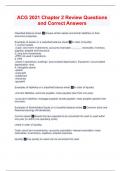Exam (elaborations)
ACG 2021 Chapter 2 Review Questions and Correct Answers
- Course
- Institution
Classified balance sheet Groups similar assets and similar liabilities on their economic properties. Examples of assets on a classified balance sheet In order of liquidity 1. Current assets >Cash, short term investments, accounts receivable, _______ receivable, Inventory, supplies, prepaid rent...
[Show more]



